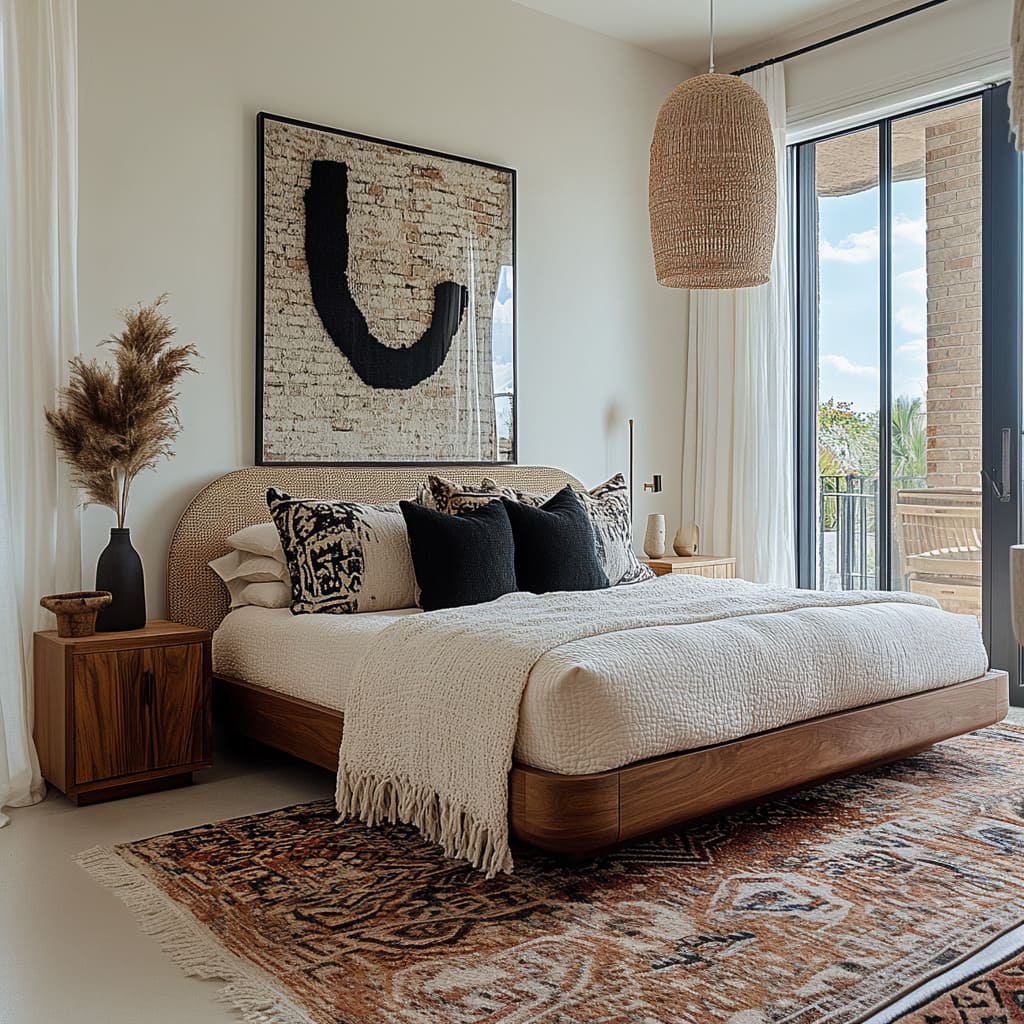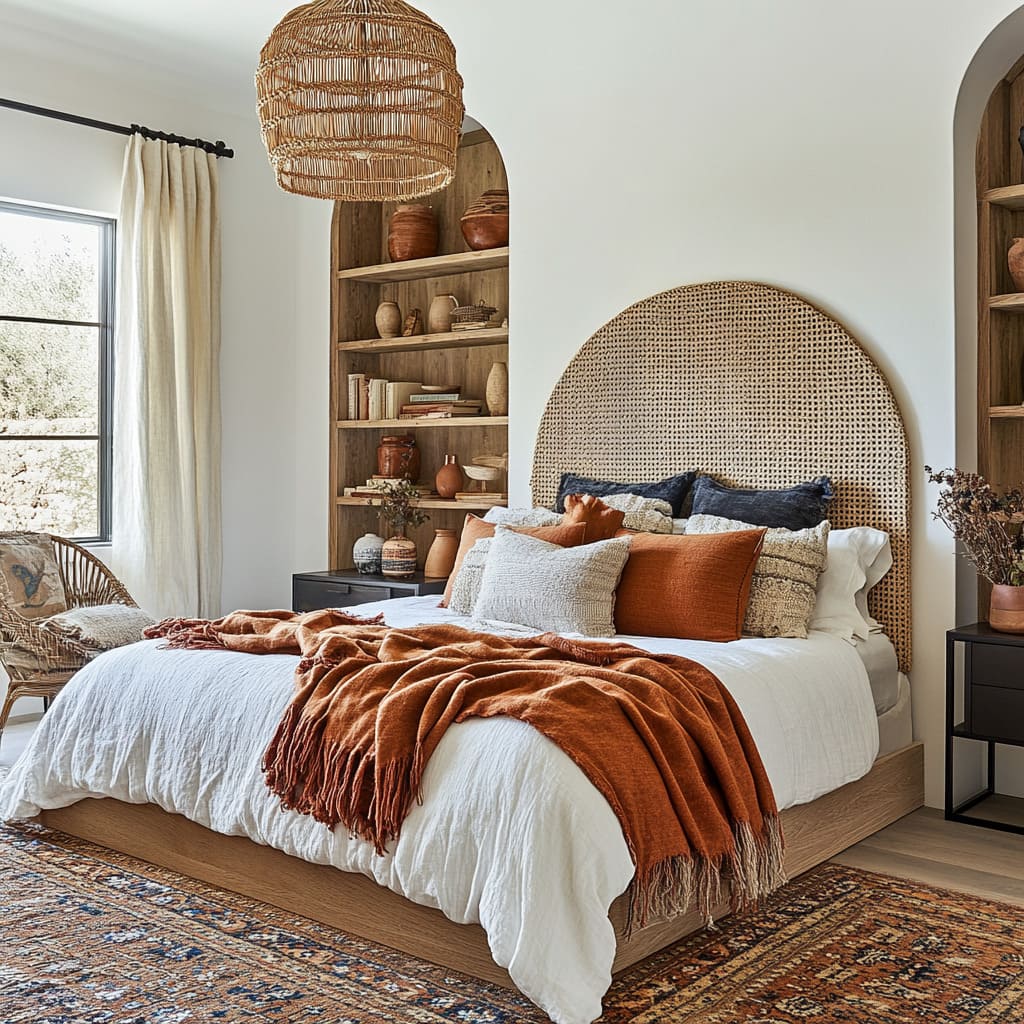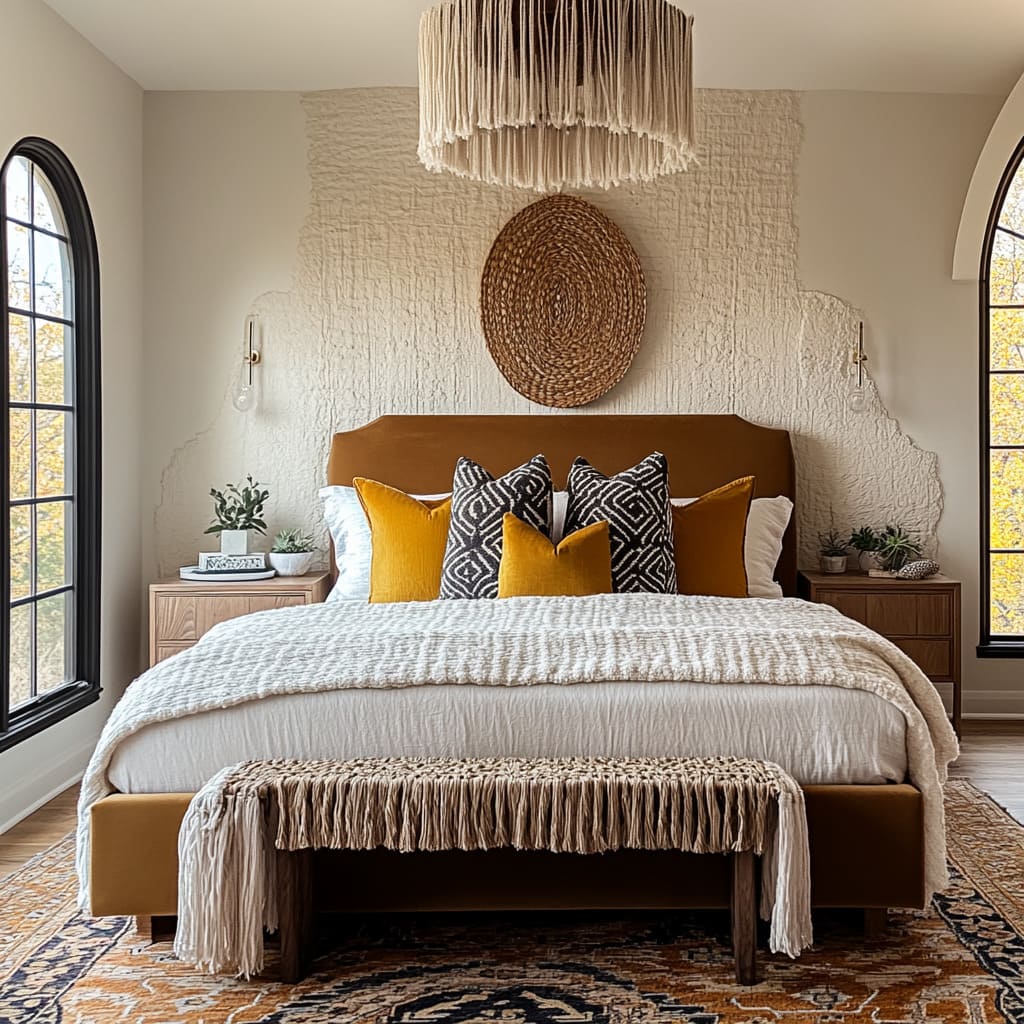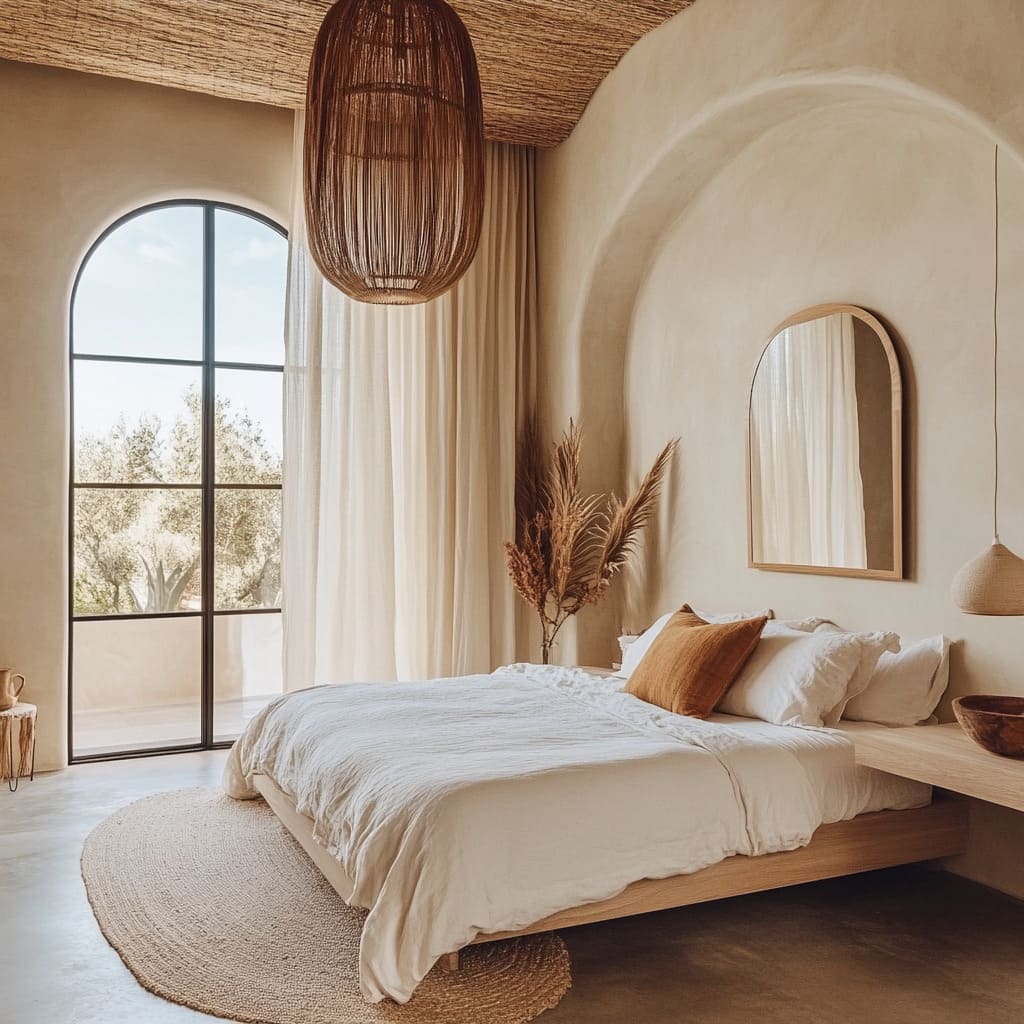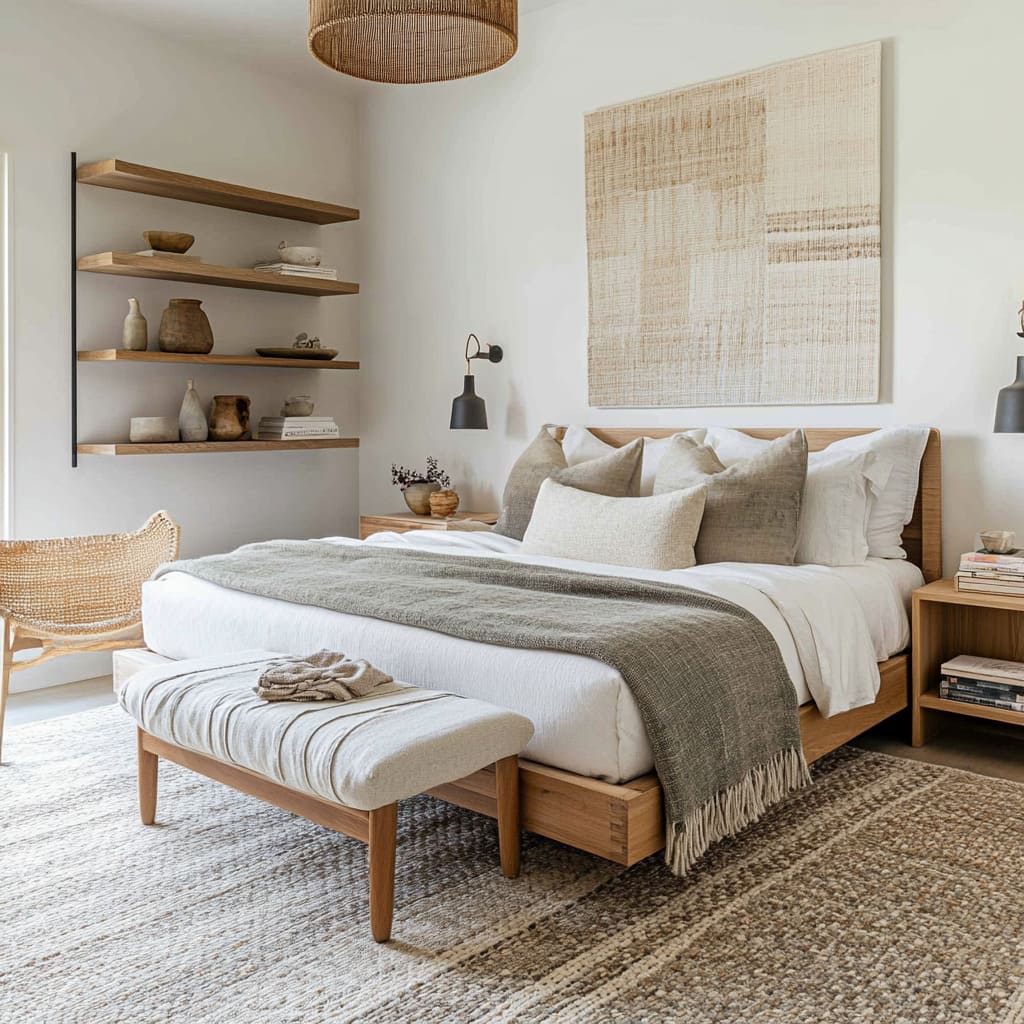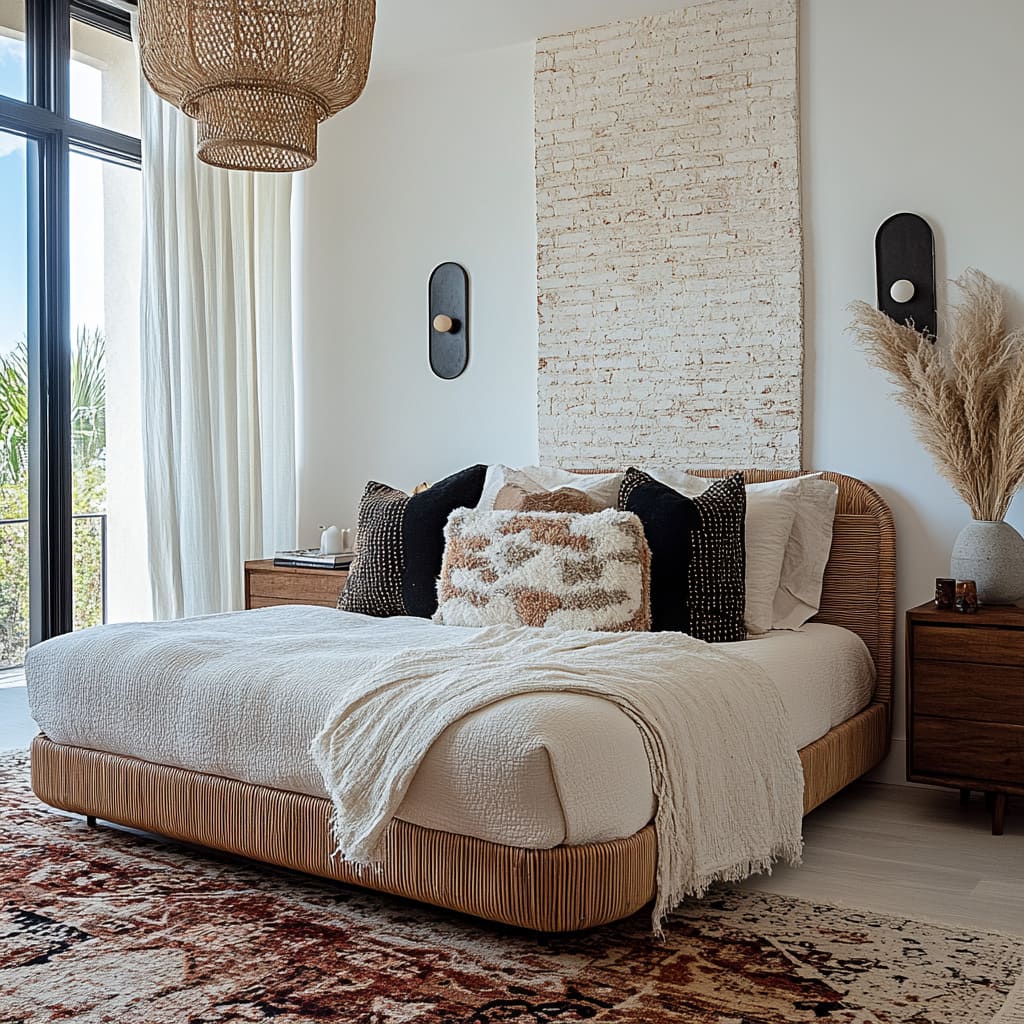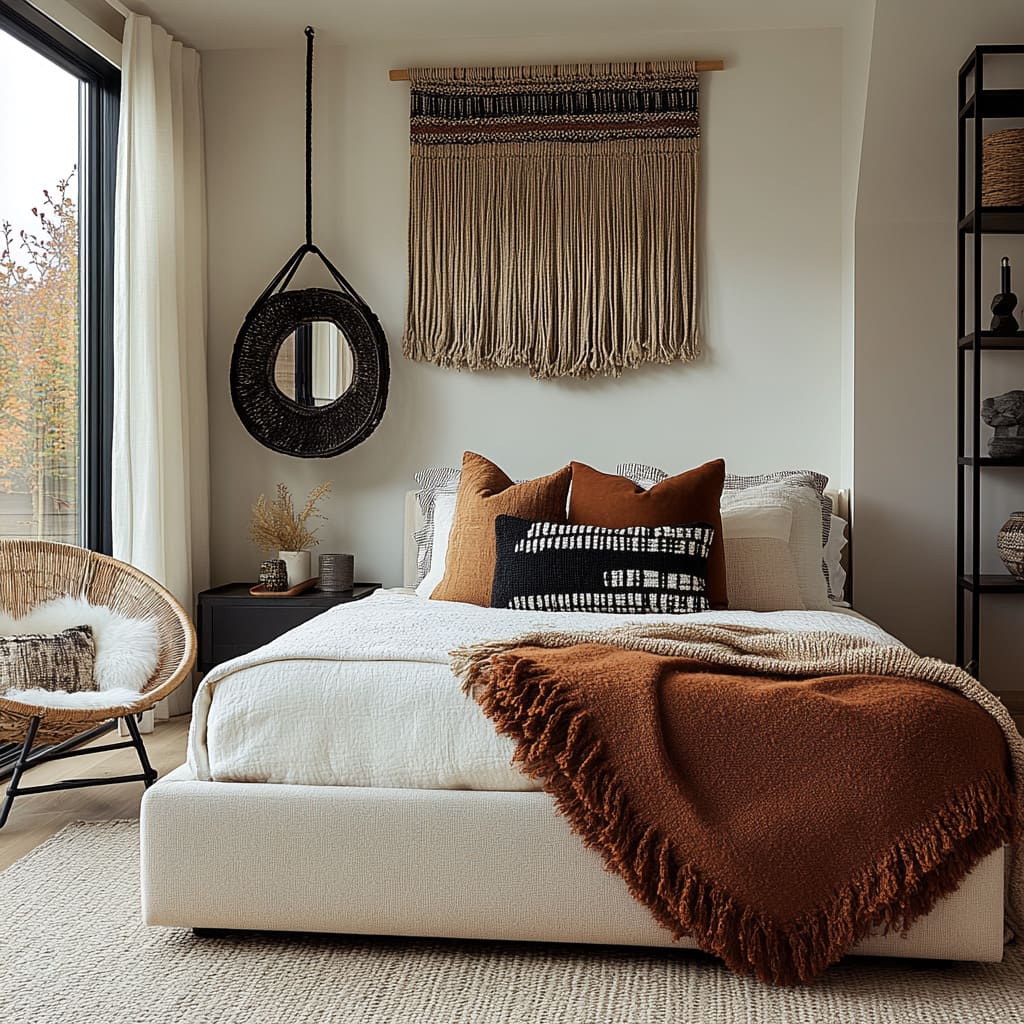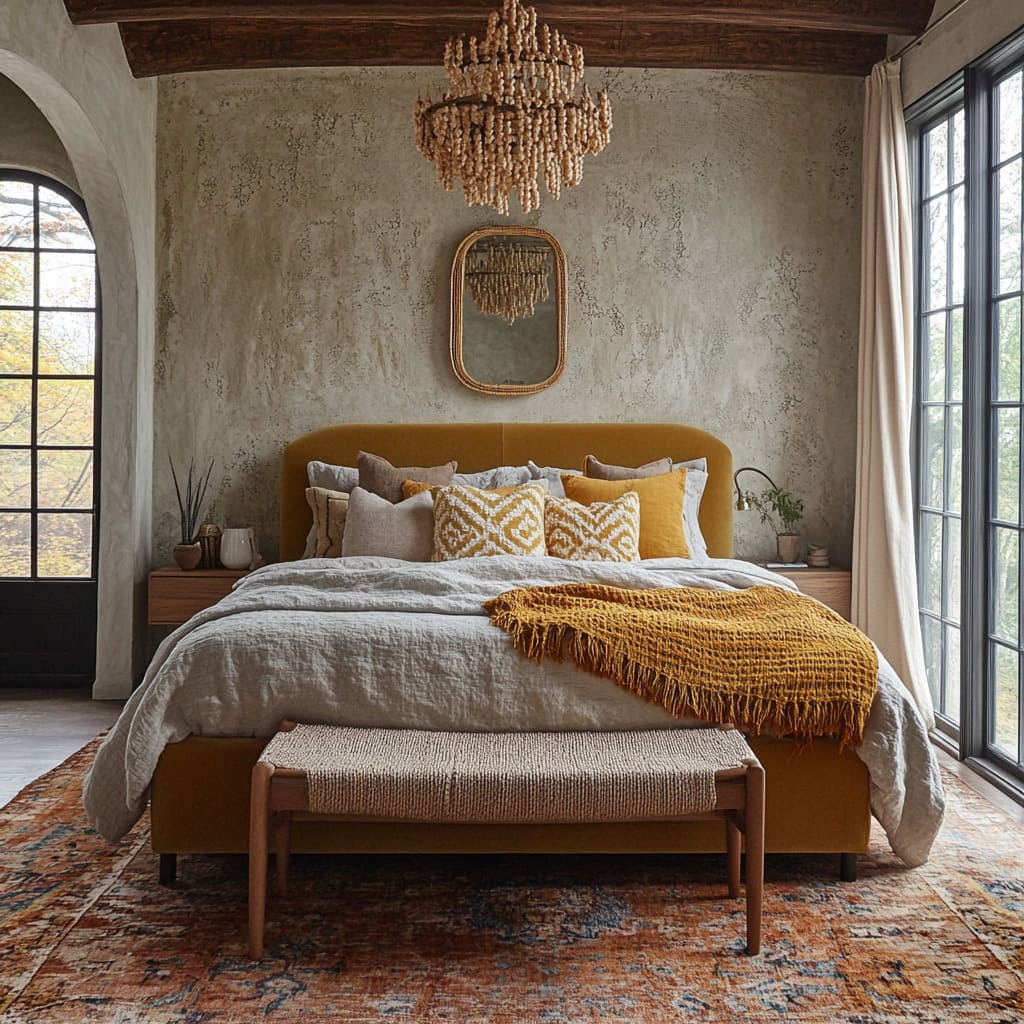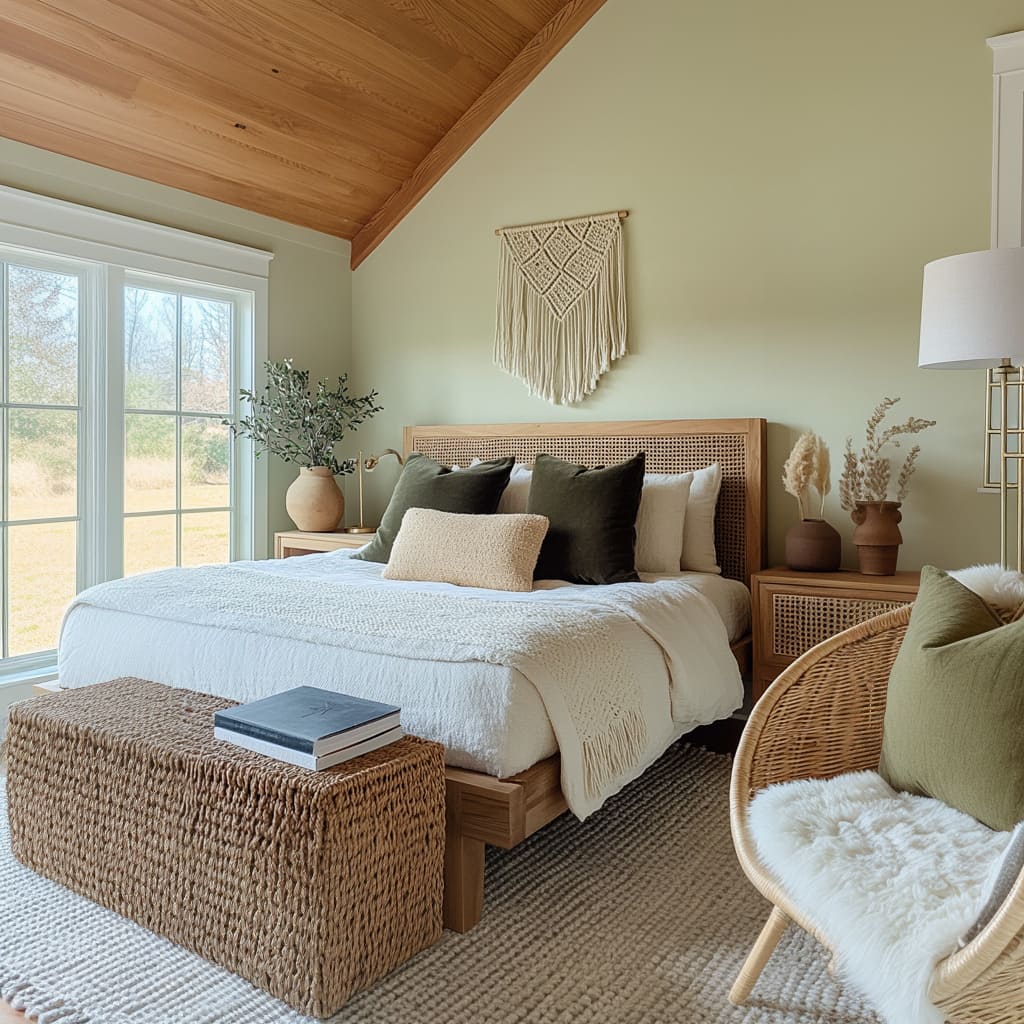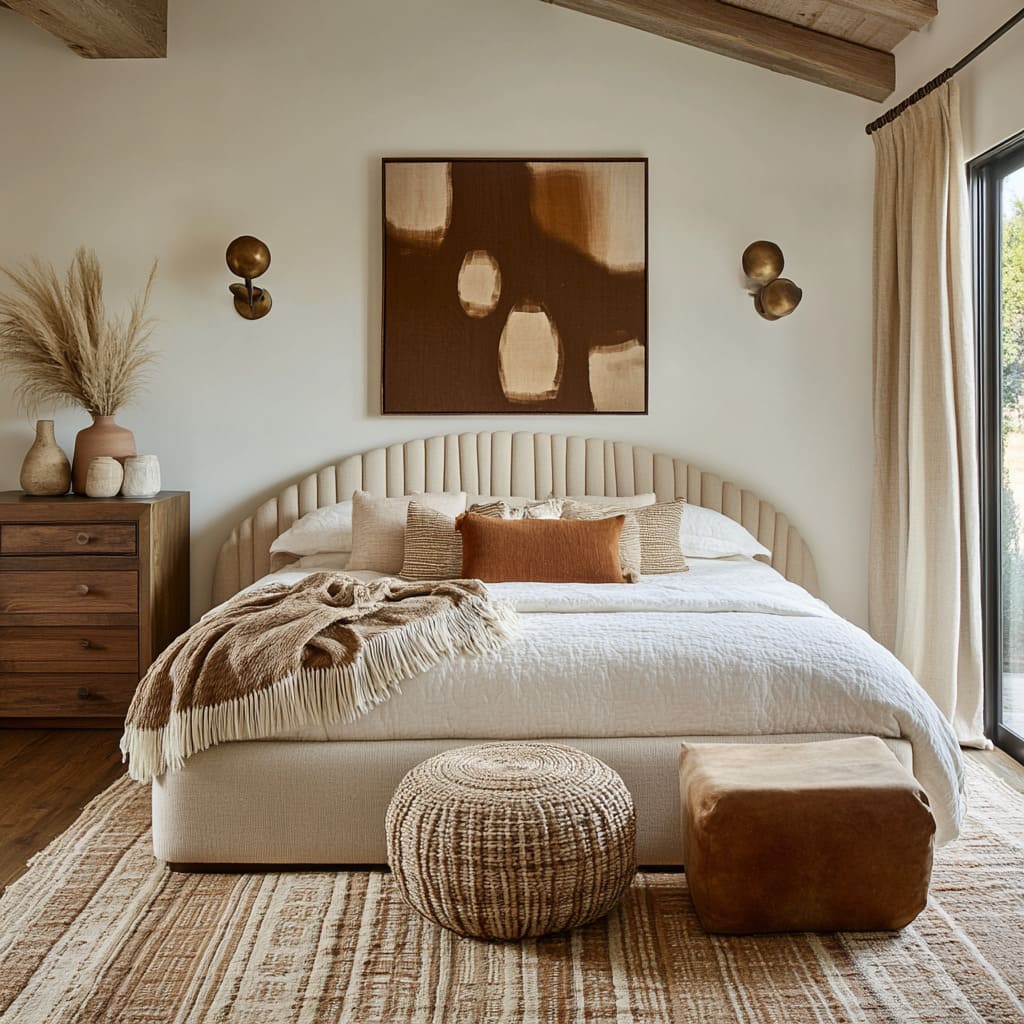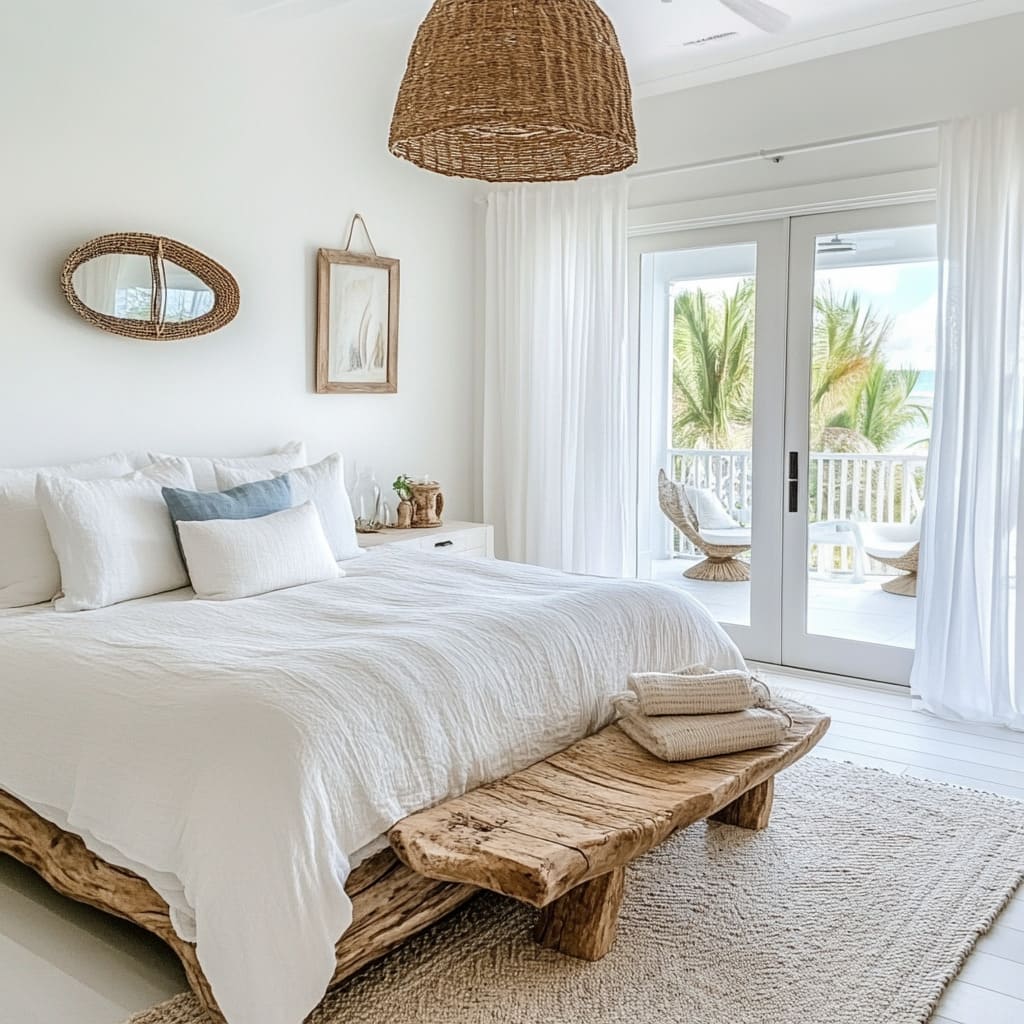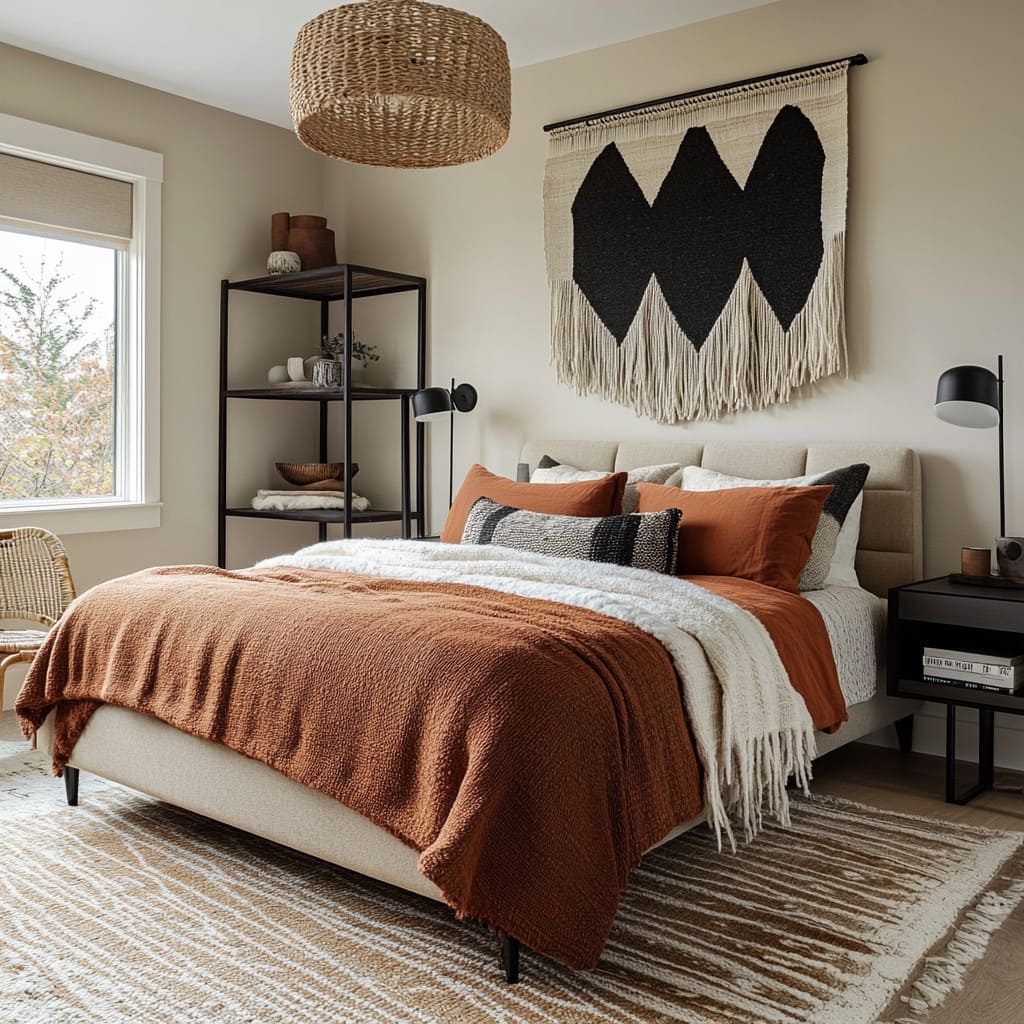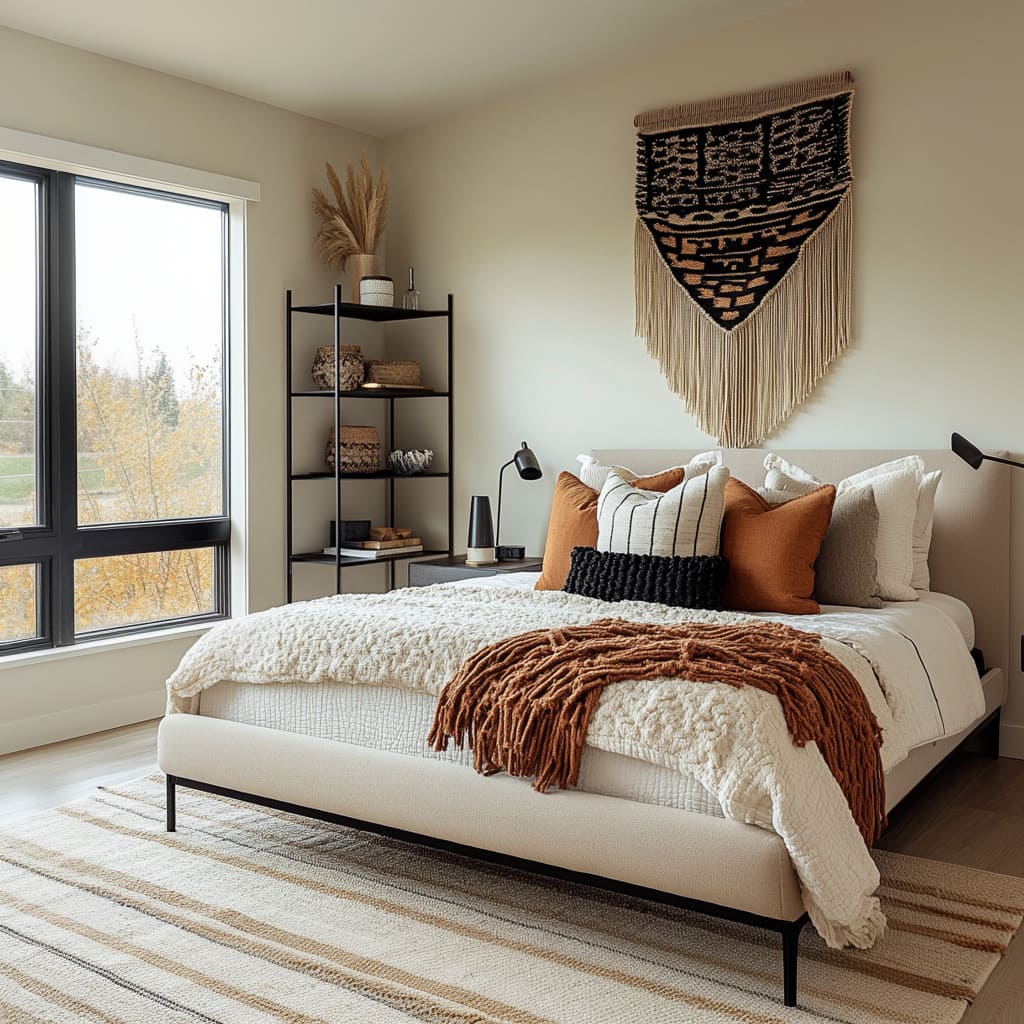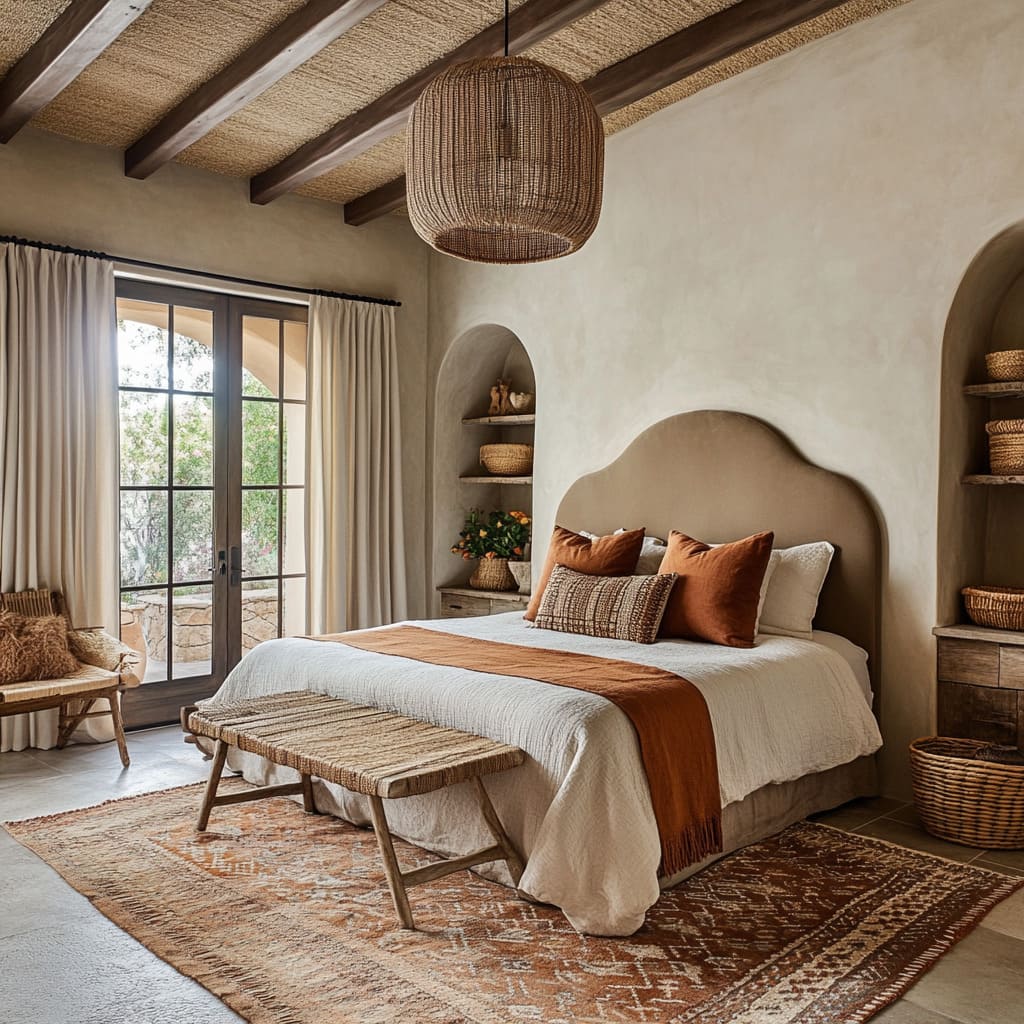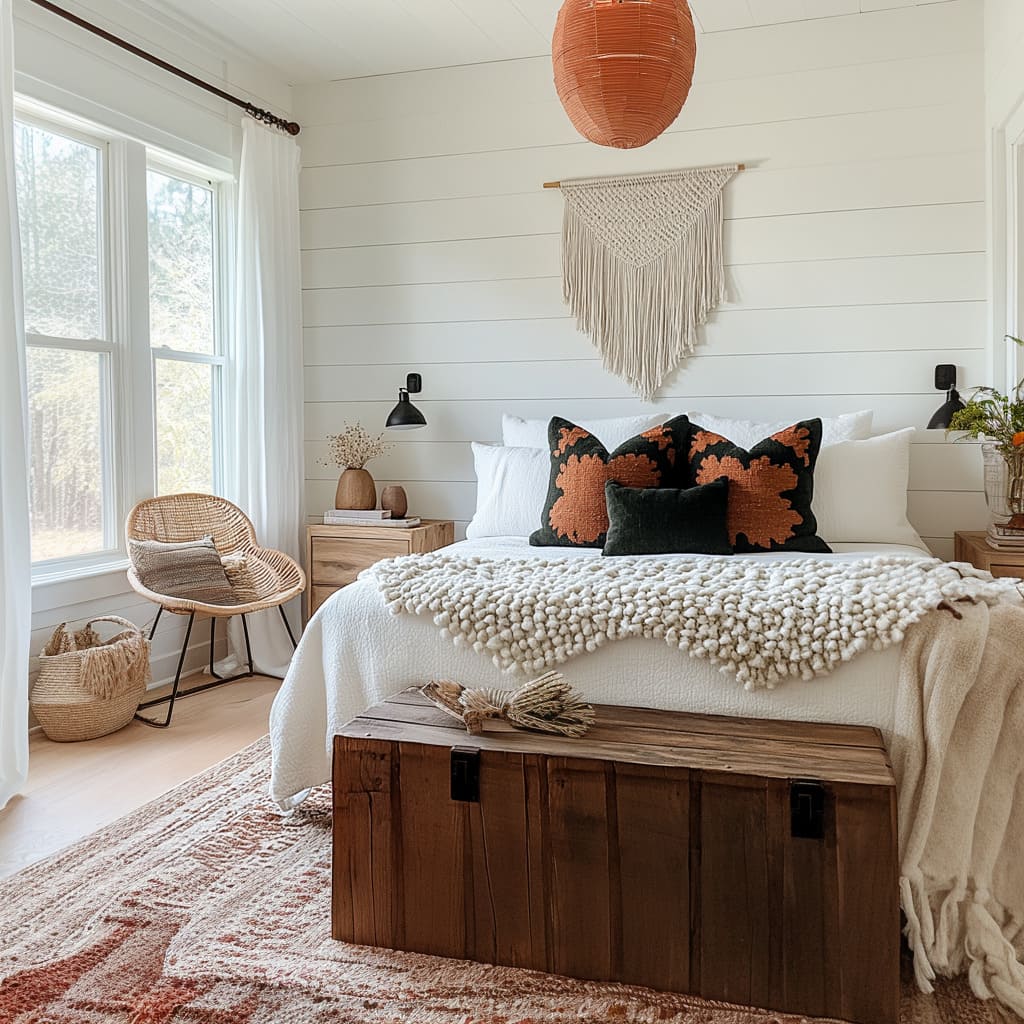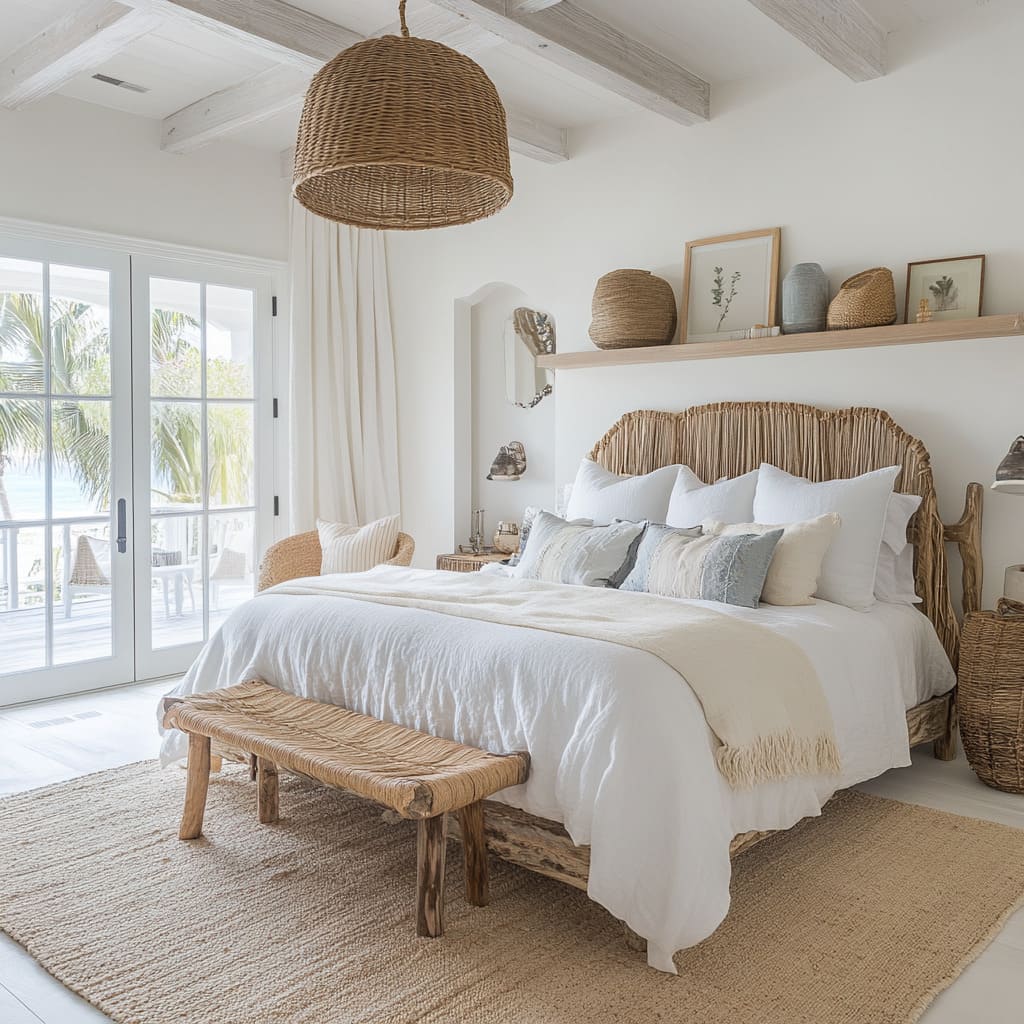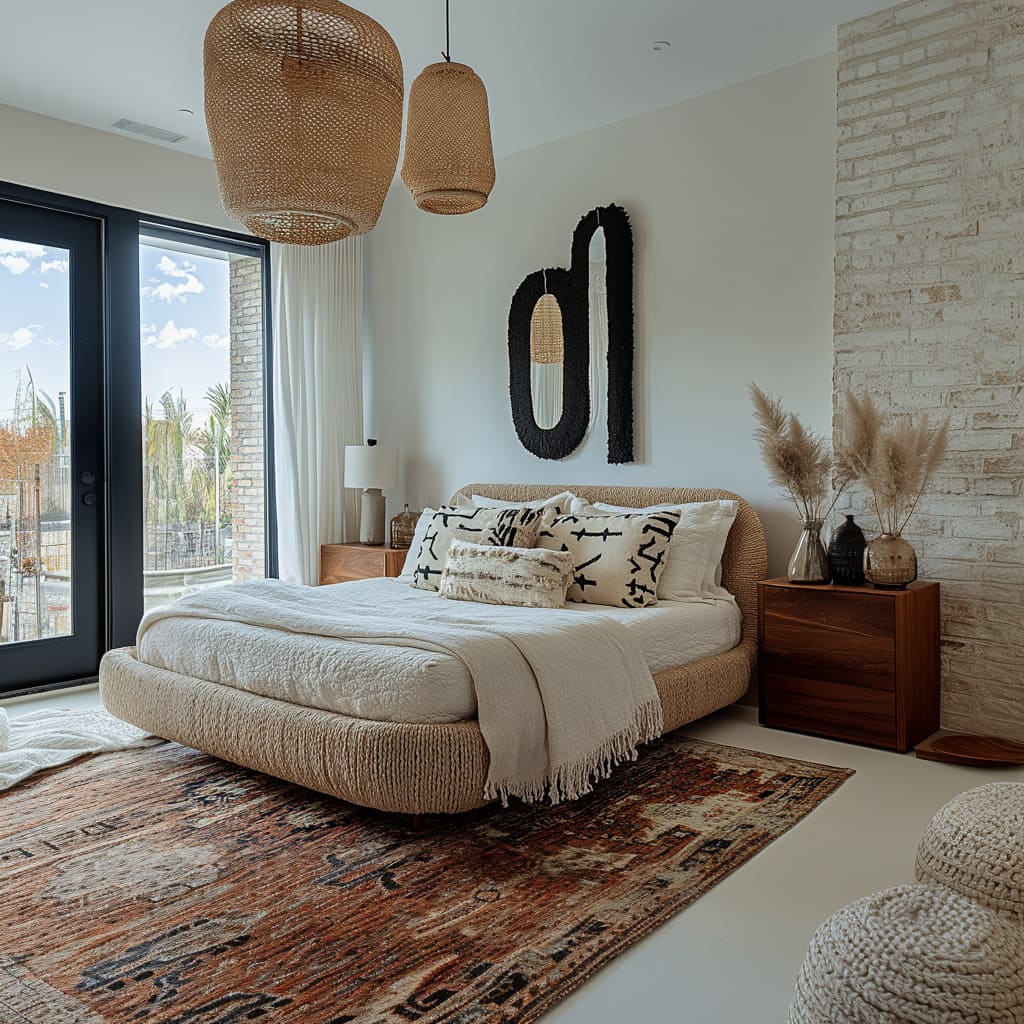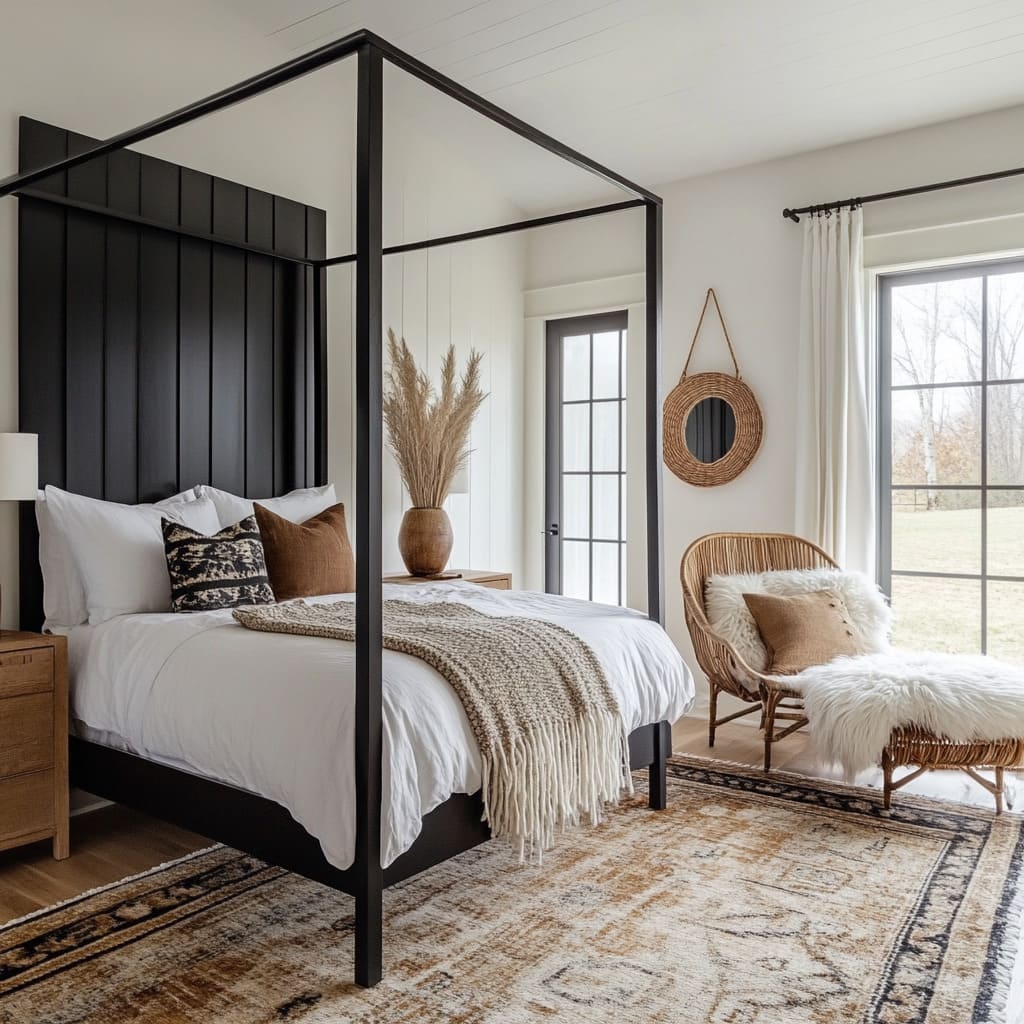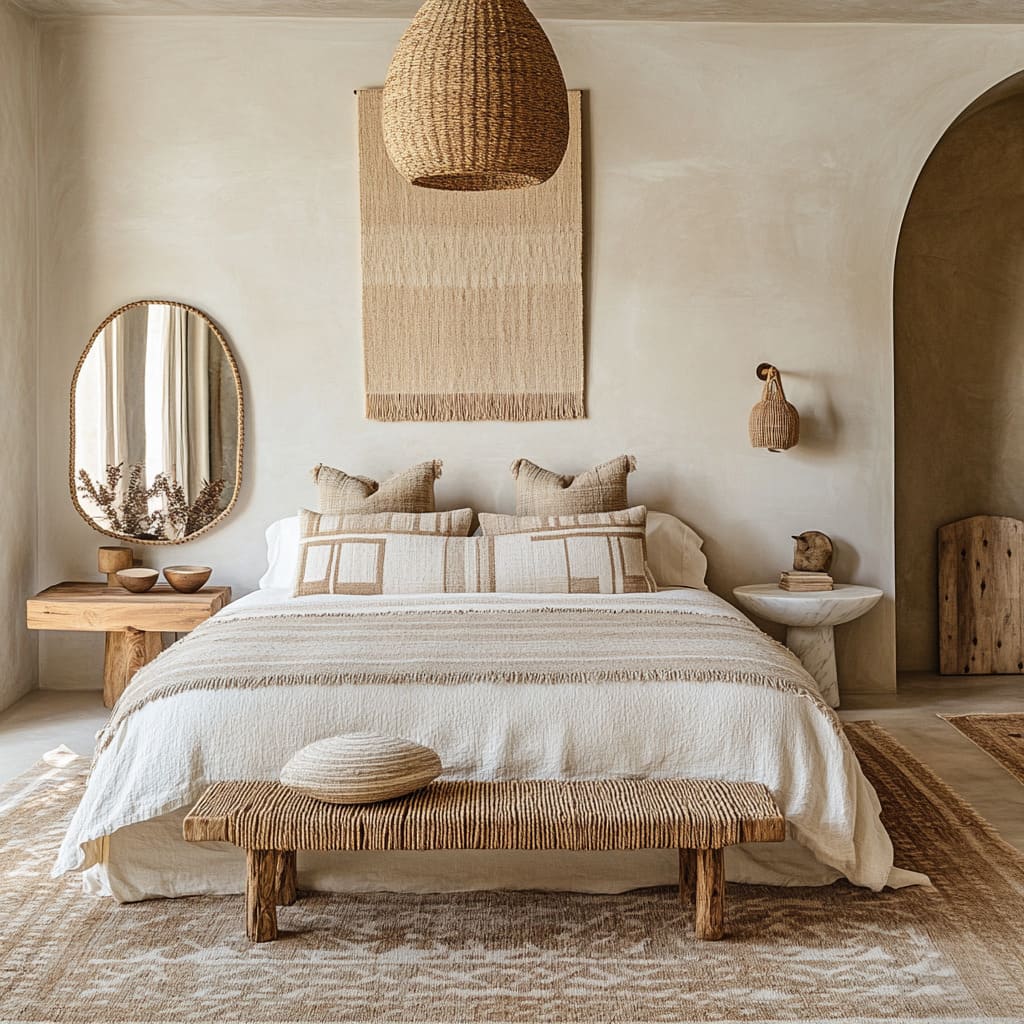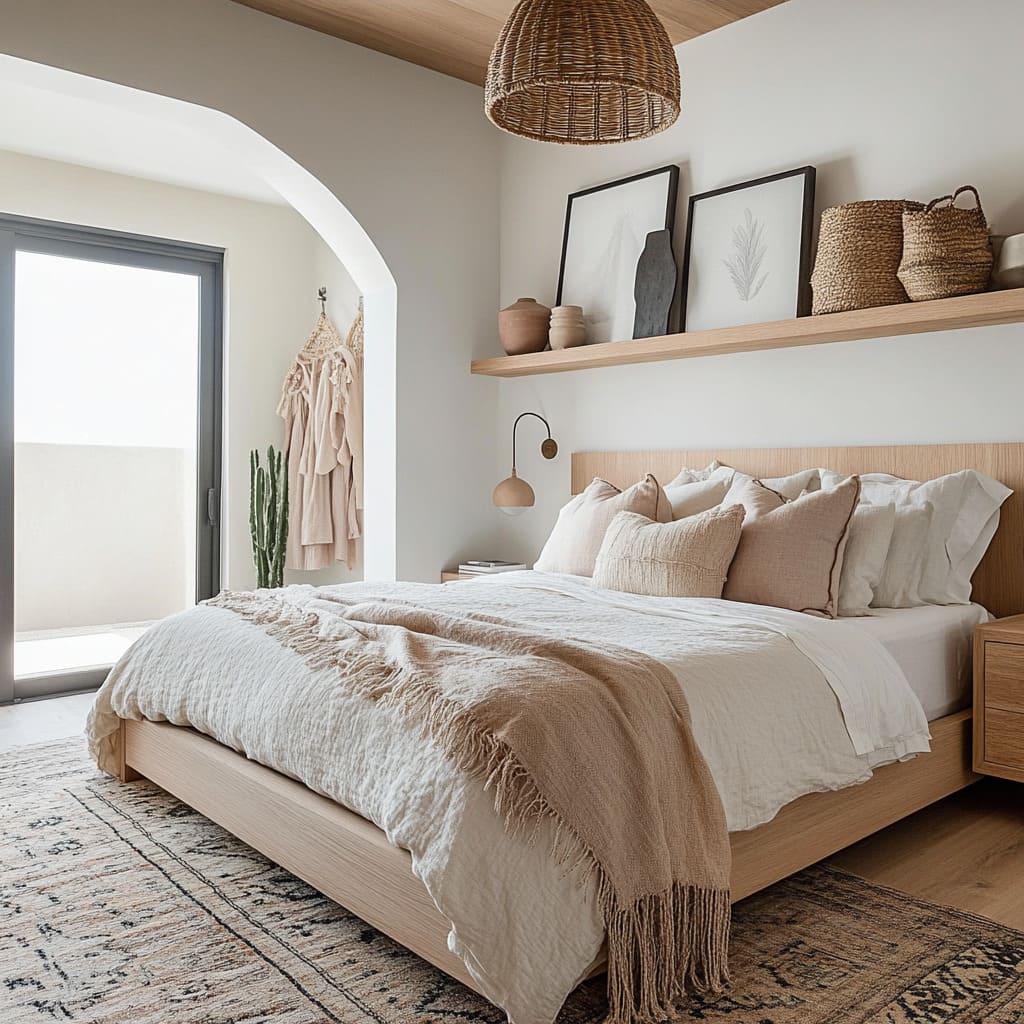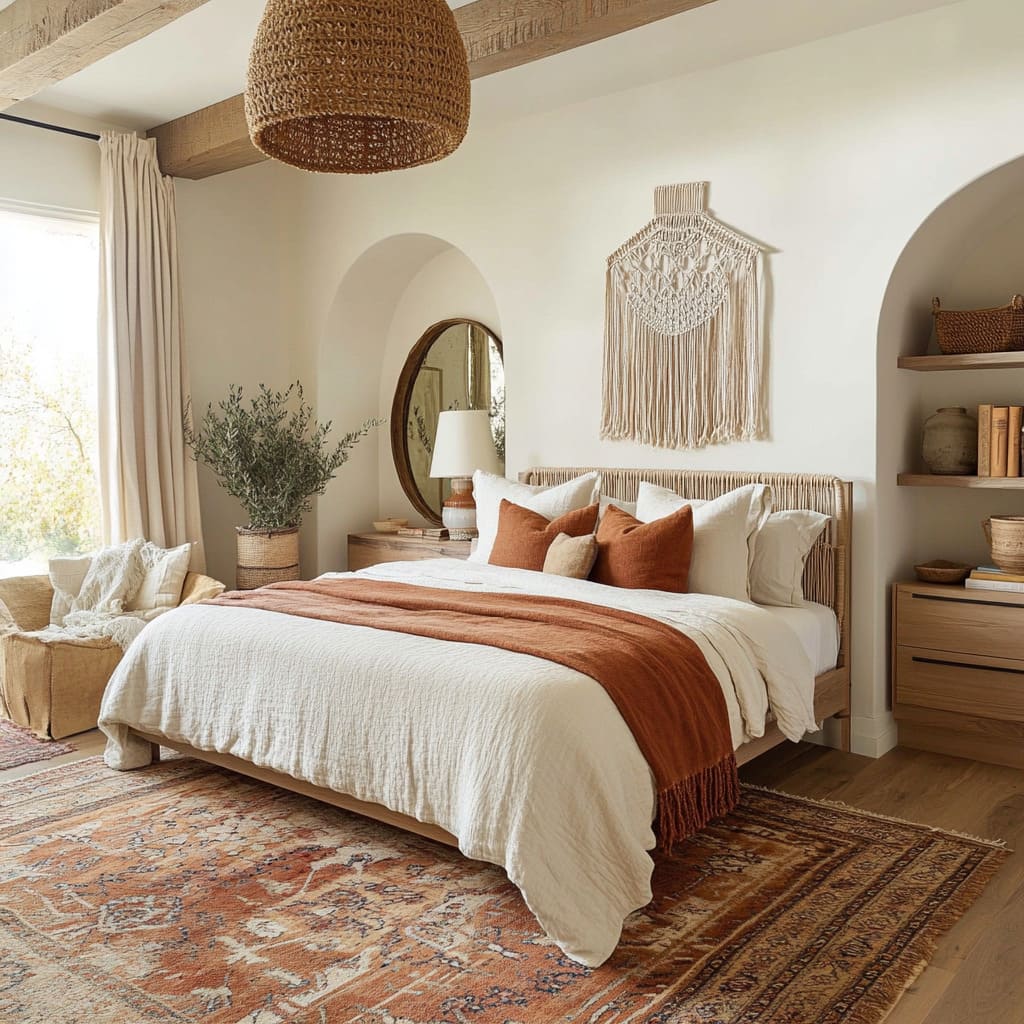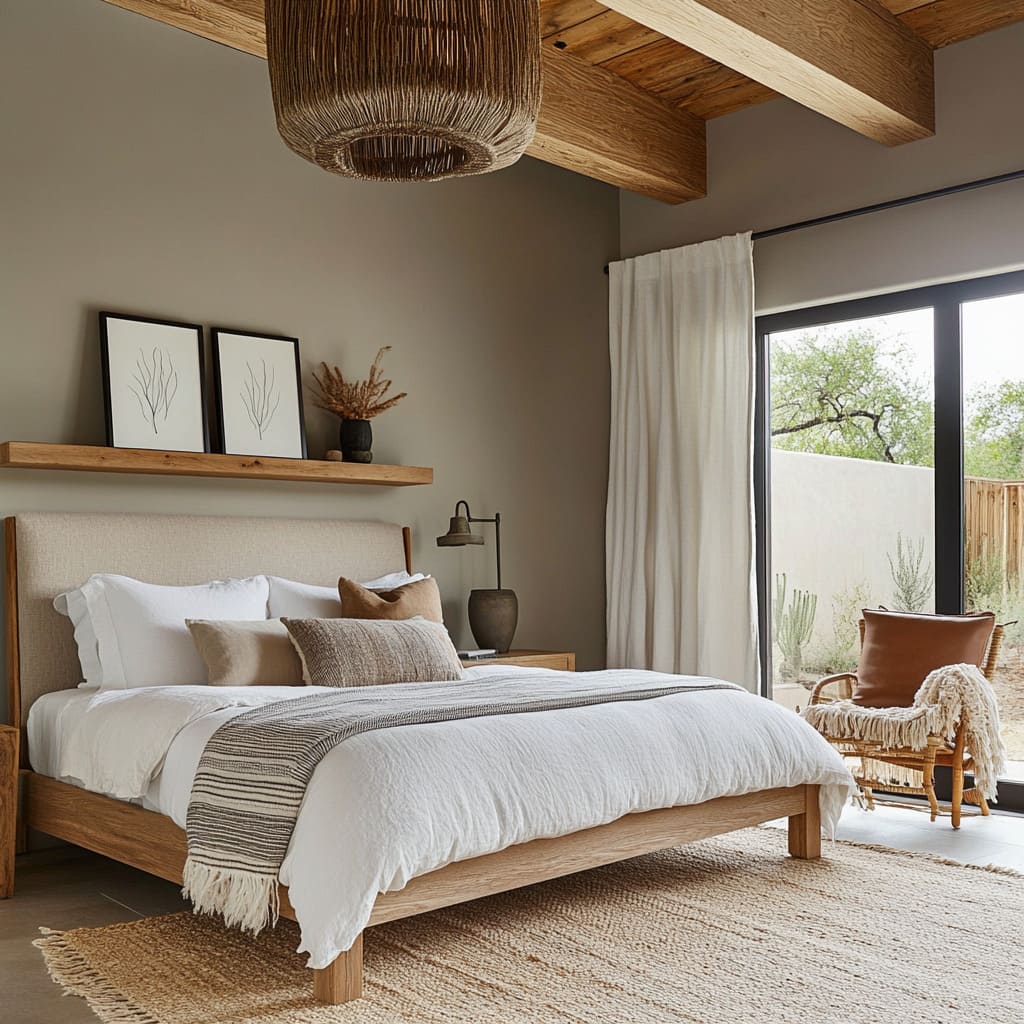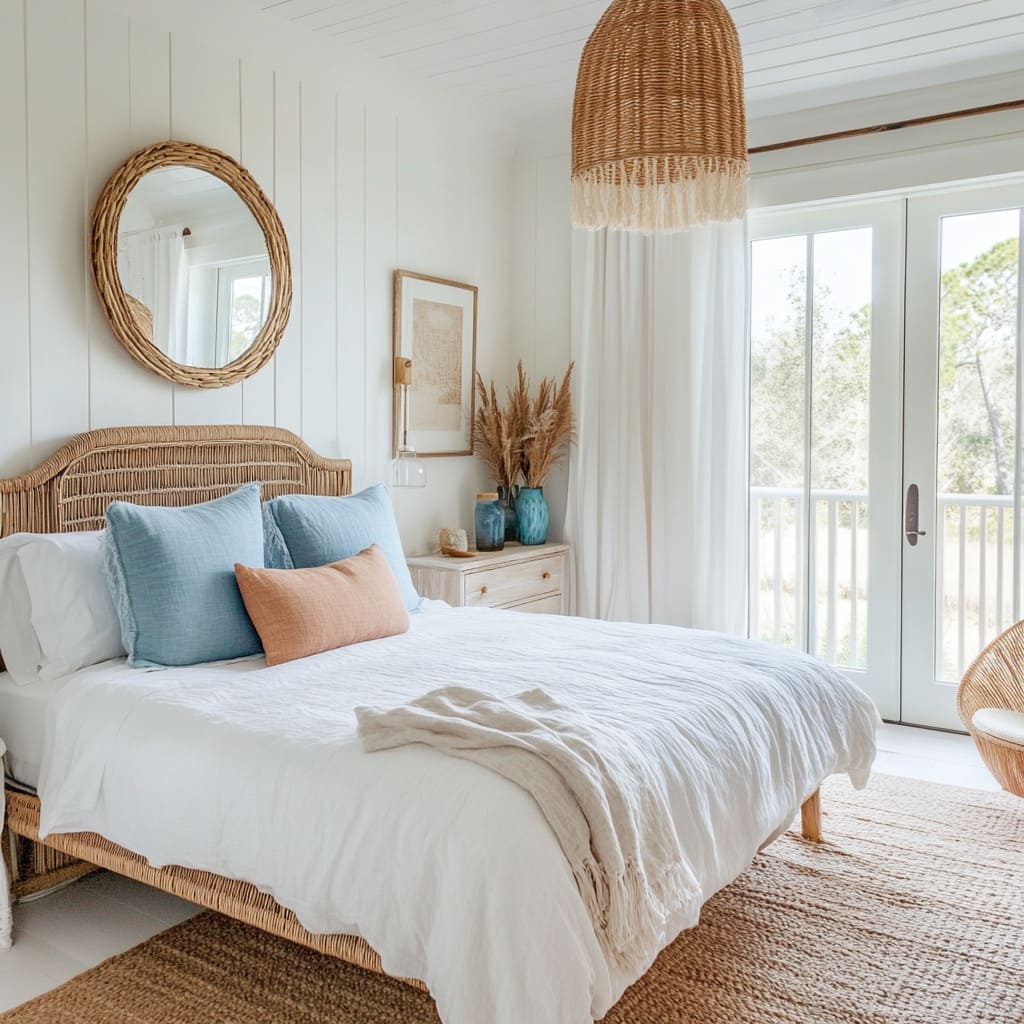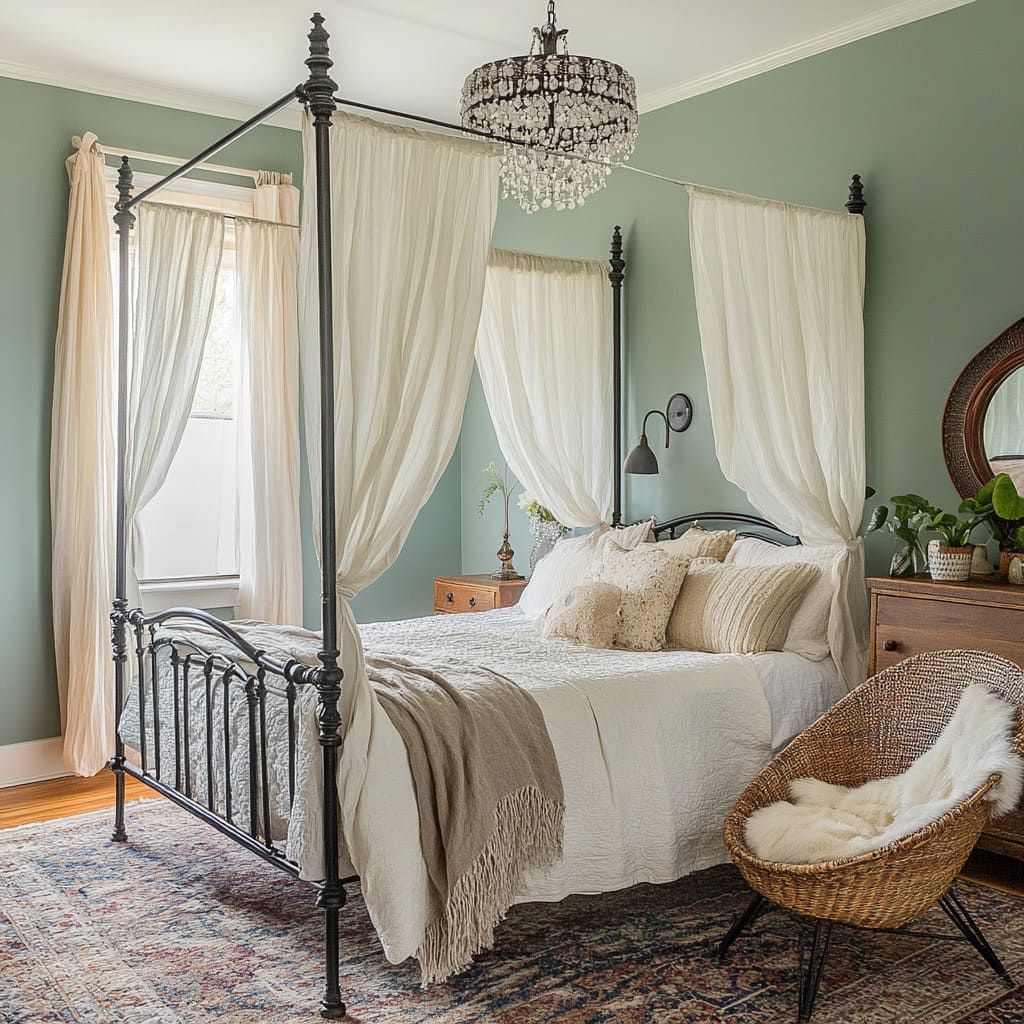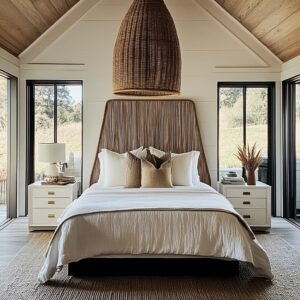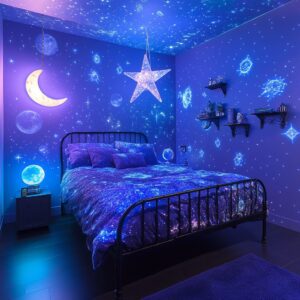A boho-inspired bedroom is more than just a collection of furniture and decor—it’s about creating a space that feels layered, inviting, and full of personality. Unlike overly structured interiors, this style embraces natural textures, earthy tones, and handcrafted elements that give a sense of comfort without feeling overly curated.
What makes boho bedroom decorating ideas stand out is their versatility. Some designs lean into a coastal vibe with breezy linens and rattan details, while others take on a Mediterranean feel with textured walls and sunbaked hues.
For those who love a modern twist, clean lines and sleek accents can bring a fresh contrast to the organic materials. No matter the direction, the core elements remain the same: layered textiles, warm neutrals, and a balance of structured and relaxed pieces.
In this guide, we’ll break down the design details that make these spaces feel effortlessly put together. From the interplay of shapes to the strategic layering of textures, these insights will help you bring a natural, easygoing feel to your bedroom without losing a sense of cohesion.
Whether you’re starting from scratch or looking to refine an existing space, these ideas will help you create a room that feels inviting, stylish, and entirely your own.
Motifs and Shapes in Boho Bedroom Design
Curves and Arches: Softening the Space with Flowing Lines
Boho bedroom ideas often lean into natural, relaxed shapes, with curves and arches appearing throughout the design. From rounded headboards to softly arched alcoves, these elements create a fluid look that contrasts beautifully with structured architectural details like shiplap walls or built-in shelves.
The repetition of these organic shapes—whether in dome-shaped pendant lights, arched mirrors, or curved furniture—subtly guides the eye through the space, creating a sense of movement without overwhelming the decor. This strategic use of curved forms isn’t just about aesthetics; it also enhances the inviting, unforced nature of the space.
Unlike rigid, geometric layouts, which can sometimes feel too structured, these gentle contours help soften the room, making it feel effortlessly layered. In some designs, archways frame doorways or built-in shelving, echoing the roundness found in woven baskets or sculptural vases.
This repetition of curves brings a natural unity to the space, ensuring every piece feels like part of a larger, harmonious composition.
Balancing Angular and Organic Elements
While rounded edges define much of the aesthetic, contrast is key to keeping the design interesting. Many boho bedrooms incorporate straight lines—whether through a black canopy bed, sleek floating shelves, or rectangular artwork—to create a visual break from the softer elements.
The balance between these clean edges and more relaxed, textural additions like woven pendant lights or knotted macramé wall hangings prevents the space from feeling overly curated or too rigid. This interplay between structure and softness is what gives a boho bedroom depth.
A bold, angular bed frame paired with relaxed linen bedding or a geometric rug next to a fringed pouf ensures the room doesn’t lean too far in one direction. Instead of competing, these elements work together, bringing out the best in each material and shape.
The contrast keeps the space feeling intentional and layered—never flat, never forced.
Textural Layering Beyond the Obvious
Tactile Contrasts: Mixing Surfaces for Depth
A well-designed boho bedroom relies on more than just colors and patterns—it’s the layering of textures that gives the space warmth and character. Natural fibers like cane, rattan, seagrass, and pampas grass bring in an earthy, organic feel, creating a slightly rough, matte quality that softens the space.
These materials, while beautiful on their own, become even more impactful when placed next to smoother surfaces like plastered walls, whitewashed brick, or crisp linen bedding. What makes these textural contrasts stand out is the balance between soft and structured, rough and polished.
For instance, a raw-edge wooden bench placed near a refined wooden dresser showcases the same natural material in different finishes. This subtle contrast keeps the space visually layered without relying on bold color differences.
Similarly, the way light hits a woven rattan chair versus a stone or ceramic tabletop introduces an understated play between matte and reflective surfaces, adding richness without making the space feel too busy.
Three-Dimensional Accents That Shift with Light
Flat walls don’t have to feel static—designers use sculptural wall décor to bring in a sense of depth. Instead of relying solely on framed artwork, large macramé pieces or asymmetrical woven art take up vertical space in a more interactive way.
The raised texture of these handcrafted elements creates soft shadows that change as natural light moves throughout the day, adding an evolving visual dimension. This three-dimensional layering also appears in furniture choices.
A chunky knit throw draped over a structured wooden bed frame or a stack of textured cushions arranged against a smooth linen duvet introduces subtle shifts in depth, making the room feel tactile and inviting. Even small details, like a handwoven lampshade casting intricate shadows on a plaster wall, contribute to the space’s overall richness.
This is where boho design thrives—through thoughtfully placed materials that work together rather than competing for attention.
Color Temperature Twists: How Undertones Shape the Mood
Balancing Warm and Cool Hues for an Inviting Atmosphere
A well-styled bohemian space isn’t just about layering patterns and textures—it’s also about using color in a way that feels balanced and intentional. While neutral palettes dominate bohemian chic bedroom ideas, the real magic happens in the subtle interplay of warm and cool tones.
Designers often introduce soft blues, seafoam greens, or misty grays when aiming for a breezy, coastal feel. These shades work well with light wood finishes and sheer white curtains, creating a relaxed and airy mood.
On the other hand, rooms that pull from desert landscapes tend to feature deep rusts, burnt oranges, and golden ochres. These warm accents complement richer wood tones, reinforcing an earthy, sun-drenched aesthetic that feels grounded and inviting.
The trick is in the details—warm and cool tones should feel intentional, not competing. A bedroom with sandy beige walls and rattan furniture might lean into cool-toned bedding to create a sense of freshness, while a room with crisp white walls could benefit from mustard-colored pillows or a deep terracotta rug to add warmth.
It’s all about achieving a natural flow between colors, allowing them to enhance the space without overwhelming it.
Layering Neutrals Without Losing Depth
A neutral palette can feel incredibly sophisticated, but it’s easy for it to fall flat if everything blends too seamlessly. The secret?
Variation in undertones. Instead of sticking to a single shade of beige or taupe, designers introduce a mix—some with hints of gray, others leaning slightly golden.
This subtle layering prevents the space from feeling too uniform while still keeping it cohesive. Linen bedding might have a cooler undertone, while the woven rug beneath it introduces a touch of warmth.
A chunky knit throw in off-white can add texture against a smoother, taupe-upholstered bed frame. By playing with depth in these understated ways, neutral rooms gain dimension without relying on bold color contrasts.
In the end, the success of a well-balanced color palette isn’t just about what hues are chosen—it’s about how they interact. The best bohemian interiors feel carefully blended, as if the elements naturally belong together rather than being deliberately placed.
Focal Points That Double as Functional
Statement Lighting That Does More Than Shine
Lighting in a boho style bedroom isn’t just about illumination—it plays a major role in shaping the atmosphere. Woven pendant lights, often crafted from rattan, seagrass, or jute, do more than brighten a space; their intricate patterns cast soft shadows, adding another layer of depth to the room.
Unlike traditional ceiling fixtures, these pieces aren’t always placed dead center. A slightly off-center pendant above a nightstand or a staggered pair of hanging lights over a bench creates an effortless, laid-back appeal.
Beyond their sculptural quality, these natural fiber lights connect with other textural elements, tying together woven headboards, macramé wall hangings, or rattan seating. The key is in the balance—keeping the light soft and diffused while letting the organic form of the fixture become a design feature on its own.
Benches and Low Seating: More Than Just Extra Seats
Seating in boho interiors is about comfort and flow, not just function. Many boho room ideas incorporate a woven bench at the foot of the bed or a cozy lounge chair in a sunlit corner.
These additions do more than provide a place to sit—they introduce texture, help define different zones, and make the space feel more intentional. A rattan or wood-framed bench echoes the earthy materials found in the rest of the room, reinforcing a cohesive, layered look.
Upholstered ottomans or small poufs in soft linen or vintage-inspired fabric add warmth without overwhelming the space. Meanwhile, a low-profile armchair with a relaxed silhouette can turn an empty corner into a reading nook, making the room feel more inviting.
The beauty of these functional focal points is that they never feel purely decorative or purely practical—they do both effortlessly. Whether it’s a woven pendant lamp casting a warm glow or a bench doubling as a styling element, these thoughtful details make a boho-inspired bedroom feel effortlessly complete.
Interplay of Natural Light and Textiles
Soft Light That Brings Texture to Life
Light isn’t just something that fills a room—it’s an active part of the design, shaping how textures appear throughout the day. In bohemian style bedroom ideas, designers use sheer curtains and lightweight linen drapes to let sunlight filter through softly, creating a warm and inviting atmosphere.
This gentle diffusion enhances natural elements, making woven rugs, macramé fringes, and wooden furniture grains stand out in a way that feels effortless. To keep the space from feeling washed out, contrast plays an important role.
Many designs feature black-framed windows or French doors, which act as a visual anchor. This framing not only provides structure within a neutral setting but also helps define soft fabrics and organic materials against the brightness of natural light.
The dark outlines create balance, allowing even simple linen curtains or textured wall hangings to stand out without overwhelming the space.
Bringing the Outdoors In
A true boho-inspired space doesn’t end at the bedroom walls—it blurs the line between indoors and out. Large windows and doors leading to balconies, patios, or gardens enhance the airy feel, making the room feel more expansive.
To maintain this sense of flow, designers often use rattan or wicker seating both inside and outside, ensuring a seamless transition between the two. The connection to nature isn’t just about furniture—it’s about how light shifts throughout the day, casting moving shadows on woven textures and highlighting the raw beauty of natural materials.
Whether it’s a sunlit nook with a relaxed lounge chair or an open-air balcony framed by flowing curtains, these elements reinforce the easy, lived-in charm that defines a well-designed boho retreat.
Subtle Contrast with Modern Touches
Black Metal Accents That Ground the Space
A bohemian theme bedroom doesn’t need to be entirely soft and organic—introducing modern details can sharpen the look and prevent it from feeling overly relaxed. One of the most effective ways to do this is with black metal accents.
Minimalist sconces, slim-framed mirrors, and sleek black side tables create contrast against light bedding, textured rugs, or plaster walls. This balance between dark and light gives the space more definition, allowing delicate fabrics and woven materials to stand out rather than blend into a sea of neutrals.
The contrast works particularly well in spaces that feature natural wood, rattan, or cane furniture. The richness of black metal makes these earthy materials feel more refined, ensuring that the overall aesthetic remains thoughtfully curated rather than overly rustic.
A simple black-framed mirror above a wooden dresser or a pair of understated black wall lamps beside a linen-covered bed introduces just the right amount of structure without disrupting the relaxed energy of the room.
Balancing Handmade Textures with Clean Geometric Lines
Boho interiors are known for their collected, layered feel, but modern shapes keep them from looking cluttered. Floating nightstands, sleek shelving, and linear furniture pieces add a contemporary touch, contrasting with the handcrafted elements that define the style.
This approach allows rooms to feel warm and personal while maintaining a sense of balance. For example, a handwoven macramé wall hanging gains even more presence when placed beside a crisp, geometric headboard.
A low, minimalist bench at the foot of the bed can make a chunky knit throw feel even cozier by comparison. The mix of structured and free-flowing forms ensures that the space feels cohesive rather than chaotic.
It’s this careful balance between organic and structured that makes a modern boho bedroom feel curated rather than random. By blending natural materials with subtle contemporary details, the design retains its laid-back charm while feeling fresh and intentional.
Artisanal Elements That Add Character
Macrame and Woven Wall Art: Texture That Transforms a Room
Handmade fiber art is more than just decoration—it adds depth, warmth, and a personal touch to any space. In many boho room decor ideas, large macramé pieces take up significant wall space, often positioned above the bed to create a striking focal point.
These woven hangings aren’t just visually interesting; they also play with light, casting soft shadows that shift throughout the day. The movement and layering of knots bring a tactile element that makes the room feel collected and intentional rather than simply styled.
Aside from traditional macramé, woven wall panels or rattan sunburst designs offer an alternative for those who want a more structured yet equally organic look. These textural accents pair beautifully with smooth plaster or painted walls, ensuring that the space doesn’t feel one-dimensional.
Whether oversized and dramatic or small and intricate, handcrafted fiber art instantly brings warmth to a boho interior.
Ceramics and Earthenware: A Subtle Yet Impactful Presence
Natural clay and ceramic pieces are staples in well-designed boho interiors, adding an earthy contrast to softer textiles. These elements don’t need to be bright or decorative to make an impression—most of the time, their impact comes from their raw finishes, hand-formed shapes, and organic imperfections.
A dried floral arrangement in an unglazed earthen vase can sit on a floating shelf next to stacked ceramics in muted tones, effortlessly blending artistry with functionality. Clay vessels tucked into arched niches or placed on wooden nightstands reinforce the handcrafted feel of the space, making it look as though it has been thoughtfully curated over time.
What makes these details stand out is their ability to balance the more intricate elements of a boho room. Against the layered fabrics, woven textures, and wooden furniture, ceramics introduce a grounding element—something that feels both understated and deeply intentional.
The beauty of these pieces is in their quiet presence, proving that even the smallest artisanal touches can make a space feel layered and full of personality.
Rugs as Cohesive Anchors
Layering and Placement: Defining the Space with Texture
A well-chosen rug does more than add softness underfoot—it acts as a visual anchor that ties the entire bedroom together. In thoughtfully designed spaces, rugs are almost always placed beneath the bed, often extending beyond the frame to create a defined sleeping zone.
This layering effect helps separate the bed area from the rest of the room, making it feel more intentional and grounded. Beyond function, rugs bring warmth and character, softening harder surfaces like wood or stone floors.
Many designers favor vintage-inspired or tribal-patterned rugs in muted, earthy tones, as these subtly tie in with accent pillows, throws, or woven wall décor. The goal is cohesion—rather than having the rug stand out on its own, it should complement surrounding textures and colors, blending seamlessly into the overall design.
Balancing Patterns and Neutrals for Depth
For rooms that already have a lot of texture through bedding, drapes, and wall art, a more understated rug works best—perhaps a faded Persian-style piece or a simple jute weave that introduces depth without overwhelming the space. On the other hand, when the bedding is kept neutral and minimal, a patterned rug can step in to add visual interest.
A distressed design with soft geometric or floral motifs can break up the simplicity, making the room feel rich with layers while still maintaining a relaxed, effortless appeal. The key to getting the right balance lies in contrast.
A room filled with crisp white linens benefits from a rug with some age and character, while a bedroom with bold colors might feel more polished with a rug in muted, tonal hues. No matter the choice, a well-placed rug enhances the entire space, proving that flooring isn’t just a background element—it’s an essential part of the design.
Tips for Re-Creating a Similar Look in Your Bedroom
Designing a bedroom with a relaxed, layered, and natural aesthetic isn’t just about filling a space with trendy décor. The essence of a well-executed boho chic bedroom lies in the balance of texture, color, and form—creating a space that feels effortless yet thoughtfully curated.
Here’s how to bring this aesthetic into your own home while ensuring the result looks organic and inviting rather than overly staged.
Start with a Neutral Base: The Canvas for Layering
The foundation of a boho-inspired bedroom is its color palette. Instead of stark whites or bold hues, opt for softer neutrals that provide warmth and depth.
Shades like warm white, soft beige, or muted sage serve as the perfect backdrop for layering different materials and textures. If your walls already have some texture, such as exposed brick or subtle plaster, keep the color muted to enhance the organic feel.
The goal is to establish a neutral starting point that feels light and airy without being dull or flat.
Layer Textures in Moderation: Finding the Right Balance
One of the hallmarks of boho interiors is the mix of woven, plush, and structured materials. However, achieving the right balance is crucial—too many heavily textured elements can make a space feel cluttered.
Start with a key feature, such as a rattan headboard or a woven pendant light, and build around it with complementary textures. Soft linen bedding, fringed throws, or macramé wall hangings add depth without overwhelming the space.
Curate Accents with Purpose: Less Is More
Boho interiors embrace a collected-over-time feel, but that doesn’t mean every inch of the space should be filled with décor. Instead of scattering multiple small pieces, focus on a few statement accents.
A large macramé hanging, a vintage-style rug, or a sculptural mirror can serve as focal points without overwhelming the design. If displaying decorative objects, group similar materials or shapes together for a cohesive look.
Vary Tones in Neutrals: Avoiding a Flat Look
Neutrals are the foundation of most boho spaces, but sticking to just one shade can make the room feel uninspired. The key is to introduce variations in tone—mixing warm browns with cooler grays, creamy whites with sandy beiges, or taupes with hints of olive green.
One way to do this is through materials. A light wood bed frame paired with deeper walnut-toned nightstands creates contrast while keeping everything within the same natural palette.
Introduce One Strong Color: A Subtle Focal Point
Boho interiors are known for earthy color schemes, but a single well-placed accent color can bring the space to life. Instead of painting an entire wall, introduce warm, muted tones through textiles, decorative pillows, or a patterned rug.
Combine Natural with Sleek: Mixing Organic Forms with Modern Lines
To keep the space feeling fresh and curated, blend handcrafted materials with a few streamlined, modern pieces. A black metal sconce or sleek nightstand can add structure to a room filled with soft linen and woven textures.
Focus on Mood Lighting: Soft and Layered Illumination
Lighting is often overlooked, yet it plays a huge role in setting the mood. Boho spaces thrive on warm, diffused lighting rather than harsh overhead fixtures.
Consider layering different types of lighting:.
- Pendant lights made from woven fibers cast patterned shadows.
- Wall sconces provide soft, ambient light.
- Table lamps with textured shades create a diffused glow.
The key is to avoid overly bright, cool-toned lighting, which can make the space feel sterile.
Reflect Light Delicately: Using Mirrors with Purpose
Mirrors do more than just serve a functional purpose—they help distribute light and make the space feel more open. Placing a mirror across from a window or near a light source can maximize brightness without artificial glare.
Keep Furnishings Low-Profile: Enhancing the Laid-Back Feel
Boho bedrooms often feel grounded and relaxed, and furniture choices play a big role. Instead of towering bed frames or bulky dressers, opt for lower-profile pieces that keep the visual weight balanced.
A platform bed or a bed with slightly raised wooden legs maintains an airy aesthetic while leaving enough negative space to prevent the room from feeling crowded.
Connect to the Outdoors: Expanding the Space Beyond Four Walls
If your bedroom has access to an outdoor space, incorporating elements that visually extend the room can enhance the open, airy feel. Even small touches—like placing a potted plant near a window or incorporating nature-inspired artwork—can reinforce the connection to the outdoors, enhancing the overall atmosphere.
Re-creating a boho-inspired bedroom isn’t about following strict design rules—it’s about finding a mix of textures, tones, and details that feel personal and inviting. By focusing on a well-balanced foundation, layering materials thoughtfully, and incorporating lighting and color naturally, you can create a space that looks effortlessly put together while remaining deeply comforting.
Additional Observations: Small Details That Make a Big Impact
A well-designed boho interior isn’t just about layering textures and colors—it’s about subtle choices that make the space feel collected, lived-in, and uniquely personal. These extra details may not always be the first thing people notice, but they create a sense of depth and authenticity that separates a well-executed space from one that feels overly staged.
Asymmetry for a Natural Look
Boho interiors embrace a sense of ease, and one of the most effective ways to capture this is by avoiding rigid symmetry. Pendant lights don’t always hang in perfect pairs, and artwork isn’t necessarily centered.
Instead, a light fixture may be positioned slightly off to one side, or a single oversized wall hanging might replace a pair of smaller pieces. This relaxed approach makes the space feel more natural, as if it has evolved over time rather than being arranged in a perfectly calculated way.
Even bedside tables don’t always match—one might be a woven basket, the other a sleek wooden stand. This purposeful imbalance adds charm, creating a look that feels effortless yet visually engaging.
Material Echoes: Creating Subtle Connections
One of the easiest ways to bring a room together without making it feel overly coordinated is through the repetition of materials. A boho-inspired space often features recurring elements—cane, linen, rattan, or aged wood—that quietly reinforce a sense of unity.
For example, cane panels on a headboard might reappear on a small accent chair across the room. A woven rattan pendant light may subtly mirror the texture of a jute rug.
Even a metal mirror frame might echo the material of a lamp base or door handle. These small connections create cohesion without feeling overly designed.
Exposed Brick and Plaster: Adding Subtle Texture
Walls aren’t just a backdrop in boho interiors—they play an active role in the overall aesthetic. Instead of high-gloss paint or perfectly smooth drywall, many well-designed spaces incorporate texture in the form of exposed brick, plaster, or subtly washed walls.
Brick, whether left natural or whitewashed, adds warmth and history without needing much decoration. Plaster walls create a raw, organic feel that complements soft linens and woven elements.
Even if your home doesn’t have original brick or plaster, it’s possible to mimic these finishes with specialized paints, textured wallpapers, or hand-applied lime washes.
Preserving Negative Space: The Power of Less
Not every inch of a boho room needs to be filled with décor. Some of the most inviting designs leave key areas intentionally open, allowing standout pieces to breathe.
A large macramé hanging over a simple wooden bed frame, an oversized woven pendant lamp against a clean plaster wall, or a single ceramic vase on an otherwise empty shelf—these choices draw the eye to key elements while preventing the space from feeling cluttered. This approach is especially useful when working with bolder textures and patterns.
If the bedding has an intricate print, keeping the wall art minimal prevents the space from feeling too busy. If the rug has a vintage design, an understated bench or nightstand can balance the composition.
Negative space also plays a role in lighting. A room packed with furniture and decor can block natural light from bouncing around, making the space feel smaller.
Leaving a few open areas—such as a clear pathway near a window or an uncluttered corner—helps keep the design fresh and airy. The best boho interiors aren’t created overnight—they evolve, with layers added over time.
Thoughtful asymmetry, material repetition, subtle wall textures, and well-preserved negative space all contribute to a design that feels both effortless and deeply intentional. When putting together a boho-inspired bedroom, don’t just focus on individual pieces—look at how they interact.
The smallest choices, like placing a pendant light slightly off-center or echoing a texture across different elements, can completely transform how a space feels. By keeping these details in mind, you can create a room that feels balanced, inviting, and uniquely yours.
Key Takeaway: Crafting a Boho-Inspired Bedroom with Personality
The beauty of boho bedroom design lies in its ability to mix warmth, texture, and handcrafted elements while keeping the atmosphere light and effortless. The designs explored here prove that this aesthetic is adaptable—whether leaning toward a coastal retreat, a Mediterranean sanctuary, or a modern interpretation, the core elements remain consistent.
Natural materials like rattan, linen, and raw wood create the foundation, while layering textiles adds depth and softness. The balance of structured and organic shapes ensures that the space feels intentional yet relaxed.
Subtle contrast—whether through black metal accents, sculptural lighting, or the interplay of warm and cool tones—prevents the room from feeling one-dimensional.
The key to achieving this look is restraint. Layering is essential, but overcomplicating the space can take away from the easygoing charm that defines boho interiors.
Thoughtful color choices, a mix of textures, and carefully chosen focal points help create a collected, inviting space without overwhelming it. By applying these principles—mixing shapes, refining colors, and keeping the design open and airy—you can create a space that feels effortlessly curated, relaxed, and full of personality.
Whether you’re drawn to soft neutrals or rich earth tones, the key is finding a balance that feels both natural and intentional, making the bedroom not just a stylish space but one that truly feels like home.
